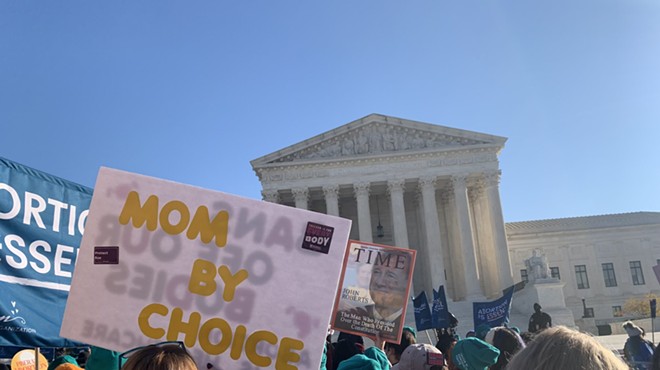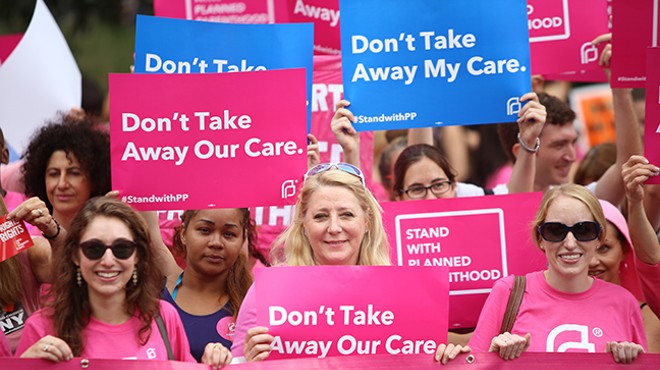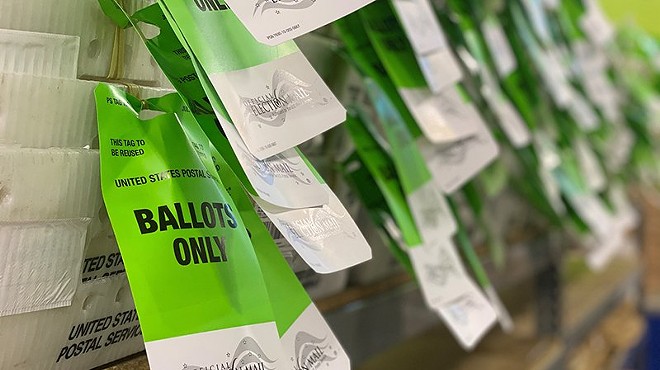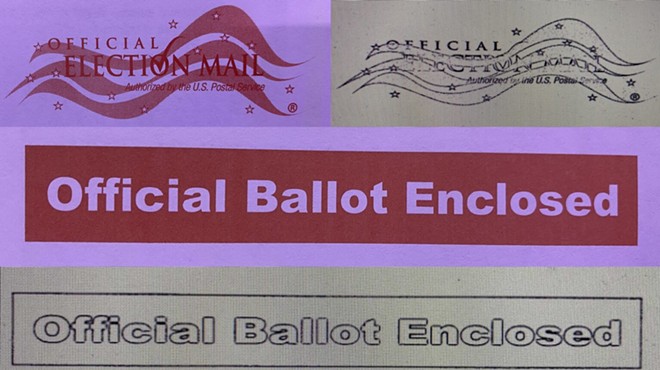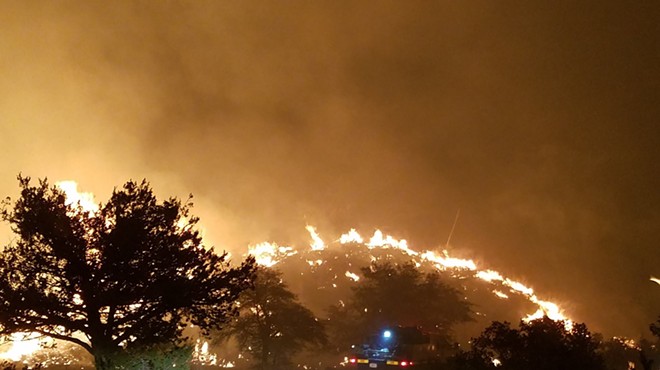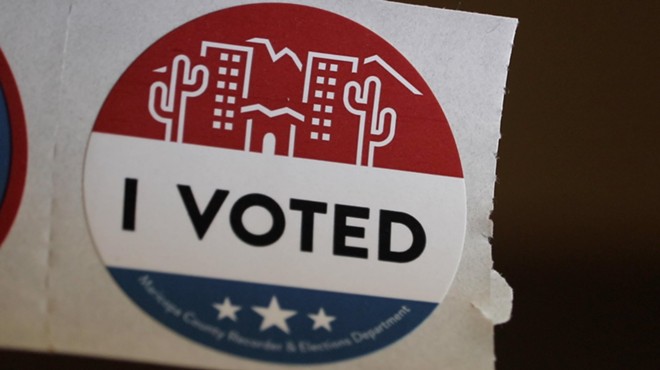Friday, April 1, 2016
Zona Politics: The Reason for Flowers, Jan. 8 Memorial Efforts and the Supercollider
April 3rd, 2016 from Zona Politics with Jim Nintzel on Vimeo.
On this week's episode of Zona Politics with Jim Nintzel: We speak with UA professor Stephen Buchmann, the author of The Reason for Flowers; Dot Kret of the January 8 Memorial Foundation about the plans for a memorial to commemorate the mass shooting at Gabby Giffords' Congress on Your Corner; and UA physicists Mike Shupe and Shufang Su, who talk about their work with the Large Hadron Collider.The show airs at 8 a.m. Sunday on the CW Tucson, Channel 8 on Cox and Comcast and Channel 58 on DirecTV, Dish and broadcast. You can also hear it at 5 p.m. Sunday on community radio KXCI, 91.3 FM. Or watch it online above.
Here's a rush transcript of the show:
(Nintzel) Hello, everyone. I'm Tucson Weekly's senior writer Jim Nintzel and we're here to talk Zona Politics. Today, we're back to talking about books. My first guest is Stephen Buchmann, a U of A professor and author of nearly a dozen books. The most recent, The Reason for Flowers, is just out in paperback. Steve, welcome to Zona Politics.
(Buchmann) Hi, Jim. It's great to be here.
(Nintzel) You know, this book The Reason for Flowers, it's really a celebration of flowers and the role they play in nature. Why do you find flowers so fascinating?
(Buchmann) The bottom line, I think, is, I like to think that if flowers didn't exist, if they hadn't come on the scene over a hundred million years ago, that maybe humans wouldn't be here. So I think of our distant common relatives as seeing flowers as the harbinger of fruits and food that would soon come next, so they noticed I think this has a lot to do with our innate preference for flowers, and the fact that since they do turn into fruits and seeds, they end up feeding the world.
(Nintzel) And we use them for romantic gestures, but they have some very strange sex lives themselves, and you get right into that at the start of the book. Talk a little bit about that.
(Buchmann) Yeah, flowers are like living billboards, signposts. So they have some of the most saturated colors in nature, other than birds and insects, which have some pretty flashy colors. Flowers signal to their pollinators and us with colors, scent with their shapes. They even have some hidden colors The ultraviolet rays that give us a sunburn actually in some flowers create ultraviolet patterns, hidden lines that, unless we have a camera with special filter, we can't see. But since bees and certain other pollinators like butterflies can see the ultraviolet they know where to probe for hidden nectar in pollen. So, in doing that sort of thing, there are flowers that "blush" when they're pollinated. They’ll turn from yellow to red, and once they're red, bees know, "Hey nothing is left. No nectar is there." There are even flowers that look like the mates of bees or wasps, so they physically look like them, they smell like them, and they're actually pollinated by, let's face it, lusty males that think they're pollinating with a real insect, or mating with a real insect.
(Nintzel) And these pollinators are pretty important in terms of taking the keeping the flowers alive. They're moving from flower to flower, spreading the genetic material and genetic diversity.
(Buchmann) Yeah, I like to say that pollinators don't get around much. They're literally rooted to the spot, so unless they're a wedding bouquet or a prom corsage, they're not getting out into the world that much. So flowers rely on these go-betweens—bees, butterflies, flies, but also in this part of Arizona, hummingbirds and bats. So they move the sex cells, the pollen, from flower to flower
(Nintzel) You've been really fascinated by bugs since a very early age. What got you hooked?
(Buchmann) I've always been fascinated with bees, for example. I started keeping honeybees in high school. And I soon moved to the bees that really fascinate me: ground-nesting bees, social bees like bumble bees, and just how they make a living, and how they interact with flowers around the world.
(Nintzel) What is going on with colony collapse with the bees?
(Buchmann) In about 2006, 2007, some Pennsylvania beekeepers popped the lid on their hives, and then found the queen and a handful of bees. The honey was there, the brood was there, but it was as if the bees were had absconded. The media jumped in and there were claims that cell phones were killing them and it was bee rapture. I don't think so. All kinds of things like that but, unfortunately, to this day we still don't know. It was kind of a perfect storm for bees. We still don't know. There's an undercurrent of pesticides—you may have heard of that neonic insecticides, which are applied to crops as seed treatments, and those are killing bees. But there's also a lack of bee food out there, the sort of bee pastures where bees go to forage and the fact that, at least for honeybees, over one million of our 2.5 million colonies of managed bees ride on the backs of 18-wheelers to the gold rush that is the almond bloom in California. So, every February and March, bees go there. and they come together, they pick up diseases, they're exposed to pesticide, so it's not a good situation.
(Nintzel) What's the consequence of losing the bees.
(Buchmann) Fortunately honeybees aren't the only bee on the block. In Arizona we've got 1,300 native species of bees. In the United States it's about 4,000. So, every crop or wildflower is not just pollinated by one bee. It's not a one-to-one situation, so, fortunately Mother Nature has some redundancy or back-up so, if the flower loses one of its pollinators, like honeybees, there are some wild bees that can step in.
(Nintzel) If people discover they have Africanized bees in their yard, in their house, what should they do?
(Buchmann) It’s a tough situation. I'm a conservationist. I don't like to kill bees. Even Africanized bees are important pollinators, but if they're near a front door or a porch or someplace where they're going to be jostled, the vibrations will set them off, and we've had something over five fatalities from Africanized bees in Arizona and hundreds of deaths of dogs and cats, horses, so sometimes the bees need to be removed, because Africanized bees are unpredictable.
(Nintzel) You've travelled all around the world. What's the most exotic flower you've come across?
(Buchmann) Probably my most exotic trip was to Borneo, and finally instead of just reading about it, came across the contender for the world's largest flower. So, it's about half the size of this table. It has a really strong smell. Actually it smells like carrion, and it's pollinated by flies. So this giant Rafflesia grows in Malaysia, Indonesia, the states of the Island of Borneo. That was probably my most memorable exotic trip, to finally see the world's largest flower.
(Nintzel) We're going to have to leave it there. The book is "The Reason for Flowers." The author, Stephen Buchmann. Thank you for coming by Steve, and we will be right back with Dot Kret from the January 8 Memorial Foundation.
(Nintzel) Joining me now on the set is Dot Kret, the incoming president of the Board of Directors of the January 8 Memorial Foundation. The Foundation is now developing a plan for a permanent memorial to remember those who were shot at Gabby Giffords' Congress on Your Corner event and to commemorate the way our community came together afterwards. Dot, thanks for joining us here on Zona Politics.
(Kret) You're welcome, Jim. Thanks for having me.
(Nintzel) So the memorial is planned for El Presidio Park in downtown Tucson. You hope to incorporate the old county courthouse, which is now empty because the offices that were there have now moved down the street to the new courthouse Tell us about the idea behind the memorial and what you hope to see?
(Kret) So the idea was that what happened in Tucson was more than just a shooting and attempted murder on January 8, 2011. The whole story is how the community coalesced, how everyone came together afterwards with support, so it's going to honor those who were killed. We lost six people that day; 13 others were injured and so many lives were turned upside-down, so we need to honor that. We also need to honor the way the community came together, and we need to honor the reason for Congress on Your Corner to begin with. It's our democracy. Communication with your elected officials is paramount to who we are as Tucsonans, and who we are as people, and so that's why we wanted it to be bigger than just a statue. And, so, using it in the courthouse area downtown in El Presidio Park, that's like the nerve central of Tucson. Because it's right downtown, it could be a beautiful park and be very vital and vibrant to downtown, so we were very lucky and very pleased when that was selected to be the base of where the memorial is going to go.
(Nintzel) And the idea is to create a space for public dialog and civic engagement. You already have people making their campaign speeches there. You have occasional protests there. So you'll kind of establish a town square where those speeches can take place in a somewhat more organized spot.
(Kret) Exactly, Jim. That's right. That's exactly what we had in mind when we were looking at it. So it's going to be outside. It's going to be very interactive. It's going to be a real Tucson thing. It's different from any other memorial that you've seen anywhere else. A lot of them are just things you go and you look at. This will be thoughtful. It will be a place for reflection and most importantly be a place for Tucsonans to come together and talk about things.
(Nintzel) A lot of people may not realize this, but you're doing this project basically in conjunction with a plan to revitalize all of El Presidio Park downtown. That's that space near city hall and the county building, probably best known for the area where you do Tucson Meet Yourself, and you'll still be able to do that, that part of it, but the idea is give that entire space a makeover.
(Kret) Correct. We had a competition among design teams from around the world. We had 68 companies from around the world who sent in designs, and so, we have selected the final team, Chee Salette, and they have come up with a beautiful, beautiful plan, not just for the memorial but for the entire El Presidio Park, that will revitalize everything The memorial itself is right on the west side of the courthouse, so when you enter the courthouse, right now you can walk under that beautiful tiled, antique dome, you can walk underneath it and then you would walk out right into the memorial, and you can just sit there and look if you like. There are going to be areas for reflection. It's going to be above and below grade. It's just beautiful, and the design is being called "The Embrace."
(Nintzel) That's the area where you'll also have space that commemorates the lives of those who were lost.
(Kret) Yes, exactly. So there'll be the exhibit. There are symbols. We have been working with this woman who is just an amazing talent who has researched the personalities of the folks who were lost and come up with symbols for them that will be incorporated into this design. So it will be a really good way to honor them, and to also promote thought and contemplation for people who are watching it
(Nintzel) And what's the price tag on this?
(Kret) So, we're thinking that the memorial itself is somewhere in the $4 million area. When we went with the bond election, we were part of that, and we were looking at a four-to-five-million-dollar price tag, and, as you know, the bonds kind of died. So, now we're looking at doing the entire thing ourselves. And we have quite a few donors. We've already raised about a million dollars for it. We have a crowdfunding campaign that we're in the middle of, now, that we're hoping to raise a sizeable chunk through there and in fact we also have an anonymous donor who has said that they will match up to $50,000 in contributions, so anything that people contribute, either just straight sending it in or through the crowd-funding campaign will be able to double that and match that. So we will raise that money and it will happen. There's all kinds of support throughout the community. We have an advisory board that's chaired by the unlikely combination but a truly wonderful one of Gabrielle Giffords and Jim Click, and they're our advisory board chairs.
(Nintzel) And crowdfunding is under way, now, and …
(Kret) Yes.
(Nintzel) … so if people want to contribute, where do they go?
(Kret) Yes. They can go to our crowdfunding website, and they can make contributions that will be matched by this anonymous donor.
(Nintzel) And we should make it clear that memorial cost is one thing; the park makeover cost is another thing.
(Kret) Right
(Nintzel) And the really big-ticket item is the rehabbing of the old county courthouse and there was hope that the bond election would cover that. A bit of a setback for that, but your responsibility is the memorial itself.
(Kret) Correct. We're doing the memorial. The rehab of the courthouse has started. The county is doing what they can do right now because it is vacant, and the design team is working with the county, they're working with the city, they're working with the downtown developers to try to see what other pieces we could put together, because when it's done, it will be just magnificent and really breathe life into that central part of downtown. And the memorial itself is going to be really lovely. I think everybody who sees the pictures and sees the design and sees the plan will be really excited. It's a good chance for Tucson to embrace what we like about each other. The hashtag #embracetucson, we're inviting people to say what they like, do your own video of what you like about Tucson under the hashtag of #embracetucson, and you can say, "I love Tucson because the Mexican food, the sunsets, the Wildcats,” or whatever.
(Nintzel) The politics.
(Kret) The politics! There you go. I love Tucson. I embrace Tucson because of the politics. And then you can put yourself online, and that's address there.
(Nintzel) And you may end up with a space in the ground floor of the county courthouse for some of the artifacts and such. We have about 30 seconds left, but there may be some kind of display within the courthouse.
(Kret) Yes, we're hoping for some of the downstairs space where we can have a computer, where we can have displays, where we can do a lot more interactive activities and have ongoing things happening there, so that's still up in the air. We're working on that, too. We have all kinds of plans.
(Nintzel) Well, it sounds like it's an absolutely fabulous plan to really commemorate the lives that were lost, the survivors and the way the community responded. Thank you so much for your hard work. Thank you, Dot Kret from the Tucson Memorial Foundation, for coming in to talk about this.
(Nintzel) That's our show for today. Next week, we'll be presenting an encore presentation of our look at the UA's Osiris Rex project. My thanks to our media partners at Tucson Weekly Tucson Local Media, and KXCI Community Radio, 91.3 FM where you can hear this show at 5 p.m. on Sunday afternoon. If you missed any part of today's show, you can find all our episodes at zonapolitics.com, and be sure to follow us on Facebook. I'm Jim Nintzel Thanks for watching. We'll see you next time.







